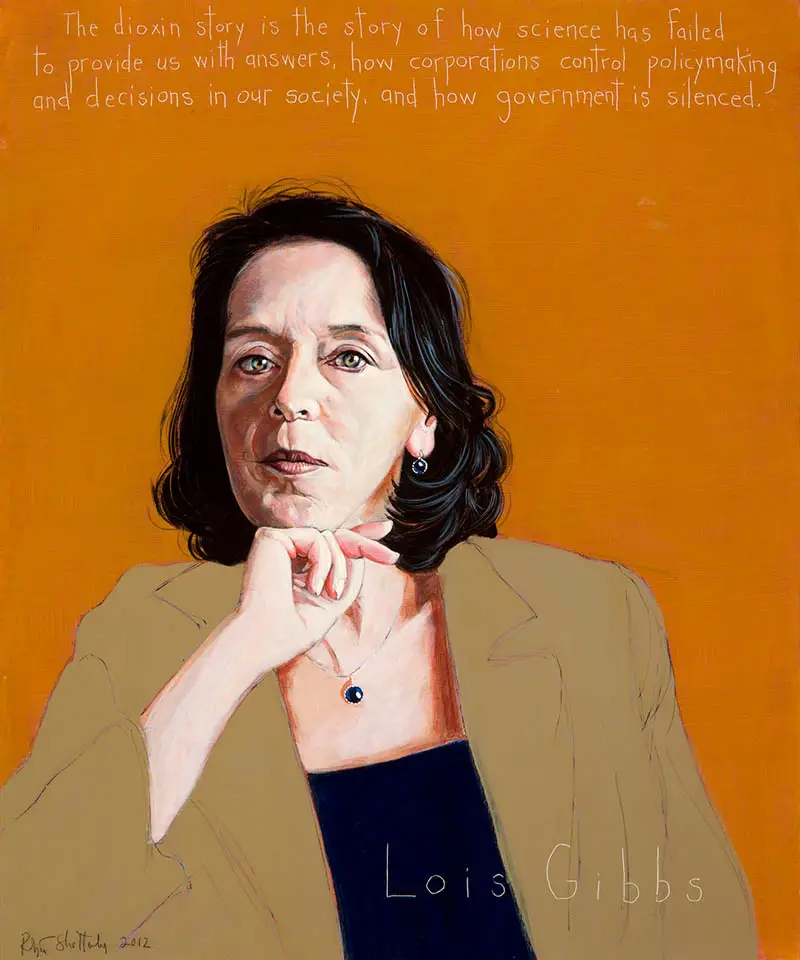
Lois Gibbs
Activist for Toxic Free Environment, Writer : b. 1951
“The dioxin story is the story of how science has failed to provide us with answers, how corporations control policymaking and decisions in our society, and how government is silenced.”
Biography
In October 1980, President Jimmy Carter signed an emergency declaration for the residents of the Love Canal neighborhood in Niagara Falls, New York. The federal government then bought over eight hundred homes and moved the families away from the toxic site when it became indisputably clear that the twenty thousand tons of toxic waste over which the community was built were making people sick.
The presidential order would not have happened without the tireless efforts of Lois Gibbs, a young mother with a sick child. In 1978, when she learned that toxins were leaching out of the ground under her home and her children´s school, she “waited at the house for somebody to knock on my door and tell me what to do at Love Canal. . . . And then when nobody came, I went and knocked on doors.” Gibbs and her husband had purchased a home in the neighborhood and could not afford to move, so she took to the streets with a petition, urging her neighbors to stand up for themselves and for their families. Meanwhile, Hooker Chemical, the company that had buried the toxins, continued to claim that nothing was wrong, despite the high rates of birth defects, miscarriages, cancers and other illnesses in the Love Canal area.
The fight for Love Canal´s health changed Gibbs’s life. Being a public figure did not come naturally to her; even speaking in front of her allies at the Love Canal Homeowners Association was a challenge. Soon, however, she was traveling widely to speak to lawmakers, regulators, and chemical company officials – most of whom were resistant to what she had to say. Their first recommendation was that pregnant women and families with children under two move away from Love Canal. When Ms. Gibbs continued to fight, she was harassed and threatened with violence.
Before she became a protester, Ms. Gibbs was a model homemaker. She cooked dinner every night, did the laundry, and took care of the kids. Months of organizing, meetings, and rallies shifted her priorities and caused tensions at home. Despite the public and private challenges, Ms. Gibbs persisted until Congress passed the Superfund Act, a government project that would identify and clean up toxic waste sites across America.
After working to bring about the Love Canal emergency declaration and the the Superfund Act, Ms. Gibbs had planned to move away from Love Canal and return her focus to her home and family.
Instead, she realized that there was more work to do. “We received all these calls from all these different people from across the country, and they were just like me. . . . I realized that I had some sort of responsibility,” she said. After a divorce, she moved to Washington D.C., with her two children and, in 1981, started a nonprofit group called the Center for Health, Environment & Justice.
In 1988, a campaign she lead convinced McDonald’s to switch from Styrofoam boxes to less wasteful paper wrappers. More recently, she pressured Target and other retailers to phase out PVC, a harmful substance found in many toys.
In 2011, she turned her attention to fracking, writing about this dangerous method of mining oil and gas in The Huffington Post. Though Gibbs´ critics say she goes too far in her fight for environmental safety, sacrificing jobs and the economic benefits of some industries, she believes that we must put our families and the earth first. If the possibility exists that a substance may cause harm, why risk our children’s health?
Now senior advisor adviser to Health, Environment & Justice, Gibbs continues to help citizens battling pollution and toxic substances in their communities.
Lois Gibbs grew up in a small town called Grand Island, New York. Her mother, Patricia Conn, said all her daughter ever wanted was “a home and a husband and children.” When people started getting sick in her neighborhood, Lois Gibbs answered the call of justice, stepping away from her dream of a simple family life to become a leader in the world of activism and environmental justice.
Programs
Americans Who Tell the Truth (AWTT) offers a variety of ways to engage with its portraits and portrait subjects. Host an exhibit, use our free lesson plans and educational programs, or engage with a member of the AWTT team or portrait subjects.

Education
AWTT has educational materials and lesson plans that ask students to grapple with truth, justice, and freedom.

Exhibits & Community Engagement
AWTT encourages community engagement programs and exhibits accompanied by public events that stimulate dialogue around citizenship, education, and activism.